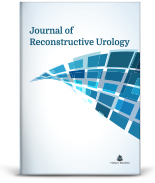Objective: Maintaining an operating field clear of blood accumulation to provide better exposure is very important to increase the success of hypospadias surgery and to decrease postoperative complications. Gas insufflation has been shown to be an effective technique to improve the appearance of the operating field. We aimed to compare whether oxygen, carbon dioxide, and room air gases used for insufflation have any advantage over each other. Material and Methods: A total of 75 patients who underwent modified tubularized incised plate urethroplasty repair for hypospadias were included in this prospective study. The patients were divided into three groups according to order of admission, and all operations were performed by the same surgeon. Group I (n=26) and Group II (n=25) used oxygen and carbon dioxide, respectively, for insufflation to provide better visualization, while room air was used in Group III (n=24). Each patient's age, operating time, follow-up duration, and postoperative complications were documented and statistically compared. Results: The demographic characteristics of the patients were found to be similar between groups. There were no statistically significant differences in complications like edema, bleeding, and urethrocutaneous fistula (p=0.708, p=0.852, p=0.730, respectively) between the groups whether oxygen, carbon dioxide, or room air were used. Conclusion: Using gas insufflation for better operative field exposure during hypospadias surgery, regardless of whether it is oxygen, carbon dioxide, or room air, contributes to a successful operation without causing the complications associated with long-term ischemia.
Keywords: Hypospadias; insufflation; oxygen; carbon dioxide; air
Amaç: Ameliyat sahasında kan birikimini azaltmak ve ameliyat sırasında daha iyi görselleştirme sağlamak, hipospadias cerrahisinde ameliyatın başarısını artırmak ve ameliyat sonrası komplikasyonları azaltmak için çok önemlidir. Gaz insüflasyonu, operasyon alanının görünümünü iyileştirmek için etkili bir teknik olduğu gösterilmiştir. İnsüflasyon için kullanılan oksijen, karbondioksit ve oda havası gazlarının birbirlerine herhangi bir avantajı olup olmadığını karşılaştırmayı amaçladık. Gereç ve Yöntemler: Hipospadias nedeniyle modifiye tubularize insizyonel plate üretroplasti onarımı yapılan toplam 75 hasta prospektif çalışmamıza dâhil edildi. Hastalar başvuru sırasına göre 3 gruba ayrıldı ve tüm ameliyatlar aynı cerrah tarafından yapıldı. Grup 1 (n=26) ve Grup 2 (n=25) sırasıyla oksijen ve karbondioksit insüflasyonu kullanılırken, Grup 3'te ise daha iyi görüntü sağlamak için oda havası (n=24) insüflasyonu uygulandı. Hastaların yaşları, operasyon süresi, takip süreleri ve postoperatif komplikasyonlar belgelendi ve istatistiksel olarak karşılaştırıldı. Bulgular: Her 3 gruptaki hastaların demografik özellikleri benzer bulundu. Oksijen, karbondioksit ve oda havası insüflasyonu kullanılan gruplar arasında komplikasyonlar açısından istatistiksel olarak anlamlı fark yoktu (sırasıyla p=0,708, p=0,852, p=0,730). Sonuç: Oksijen, karbondioksit veya oda havası fark etmeksizin hipospadias cerrahisinde ameliyat sahasının daha iyi açığa çıkması için gaz insüflasyonu kullanılması, uzun süreli iskemi komplikasyonlarına neden olmadan başarılı bir operasyona katkıda bulunur.
Anahtar Kelimeler: Hipospadias; insüflasyon; oksijen; karbon dioksit; hava
- Snodgrass W. Tubularized, incised plate urethroplasty for distal hypospadias. J Urol. 1994;151(2):464-5. [Crossref] [PubMed]
- Nelson CP, Park JM, Wan J, Bloom DA, Dunn RL, Wei JT. The increasing incidence of congenital penile anomalies in the United States. J Urol. 2005;174(4 Pt 2):1573-6. [Crossref] [PubMed]
- Donaire AE, Mendez MD. Hypospadias. 2020 Oct 1. In: StatPearls [Internet]. Treasure Island (FL): StatPearls Publishing; 2021. [PubMed]
- Fisch M. Urethral reconstruction in children. Curr Opin Urol. 2001;11(3):253-5. [Crossref] [PubMed]
- Kajbafzadeh AM, Payabvash S, Tavangar SM, Salmasi AH, Sadeghi Z, Elmi A, ET AL. Comparison of different techniques for hemostasis in a rabbit model of hypospadias repair. J Urol. 2007;178(6):2555-60. [Crossref] [PubMed]
- Kamal BA. Double dartos flaps in tubularized incised plate hypospadias repair. Urology. 2005;66(5):1095-8. [Crossref] [PubMed]
- Clavien PA, Barkun J, de Oliveira ML, Vauthey JN, Dindo D, Schulick RD, et al. de The Clavien-Dindo classification of surgical complications: five-year experience. Ann Surg. 2009;250(2):187-96. [Crossref] [PubMed]
- Morey AF. Urethral reconstruction. In: Smith JA, Howards SS, Perminger GM, eds. Hinman's Atlas of Urologic Surgery. 3rd ed. Saunders; 2014. p.237-63. [Link]
- van der Meulen JC, van der Werff JFA. The elimination of complications in hypospadias surgery: a training in analytical thought or a mission impossible? Eur J Plast Surg. 2000;23:261-6. [Crossref]
- Cakmak M, Caglayan F, Kisa U, Bozdogan O, Saray A, Caglayan O. Tourniquet application and epinephrine injection to penile skin: is it safe? Urol Res. 2002;30(4):268-72. [Crossref] [PubMed]
- Redman JF. Tourniquet as hemostatic aid in repair of hypospadias. Urology. 1986;28(3): 241. [Crossref] [PubMed]
- Belman AB. The de-epithelialized flap and its influence on hypospadias repair. J Urol. 1994; 152(6 Pt 2):2332-4. [Crossref] [PubMed]
- Schnabl SM, Herrmann N, Wilder D, Breuninger H, Häfner HM. Clinical results for use of local anesthesia with epinephrine in penile nerve block. J Dtsch Dermatol Ges. 2014; 12(4):332-9. [Crossref] [PubMed]
- Wilhelmi BJ, Blackwell SJ, Miller JH, Mancoll JS, Dardano T, Tran A, et al. Do not use epinephrine in digital blocks: myth or truth? Plast Reconstr Surg. 2001;107(2):393-7. [Crossref] [PubMed]
- Teoh KH, Panos AL, Harmantas AA, Lichtenstein SV, Salerno TA. Optimal visualization of coronary artery anastomoses by gas jet. Ann Thorac Surg. 1991;52(3):564. [Crossref] [PubMed]
- Poulton TJ. Visualization of coronary artery anastomoses by gas jet. Ann Thorac Surg. 1992;54(3):598-9. [Crossref] [PubMed]
- Demir S, Gül A. Gas (Oxygen) insufflation: a new technique for the visualization of the operative field during hypospadias surgery. Turk J Urol. 2019;45(6):456-60. [Crossref] [PubMed] [PMC]







.: Process List